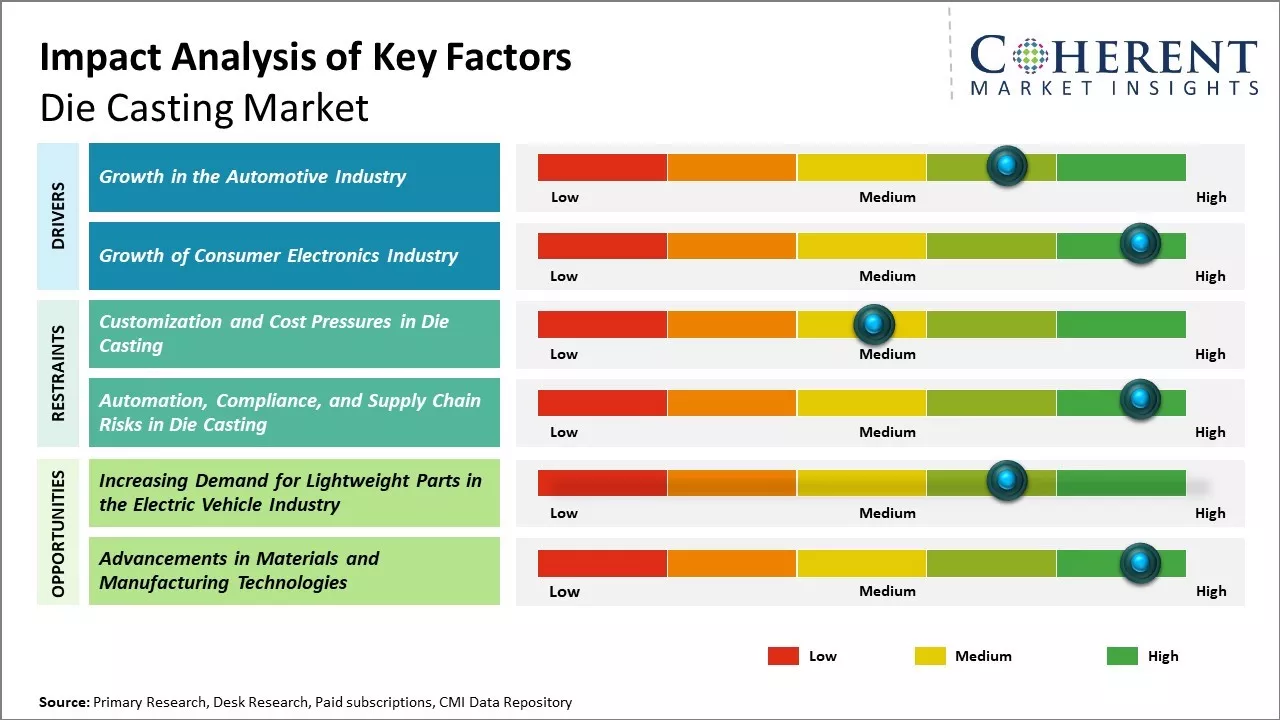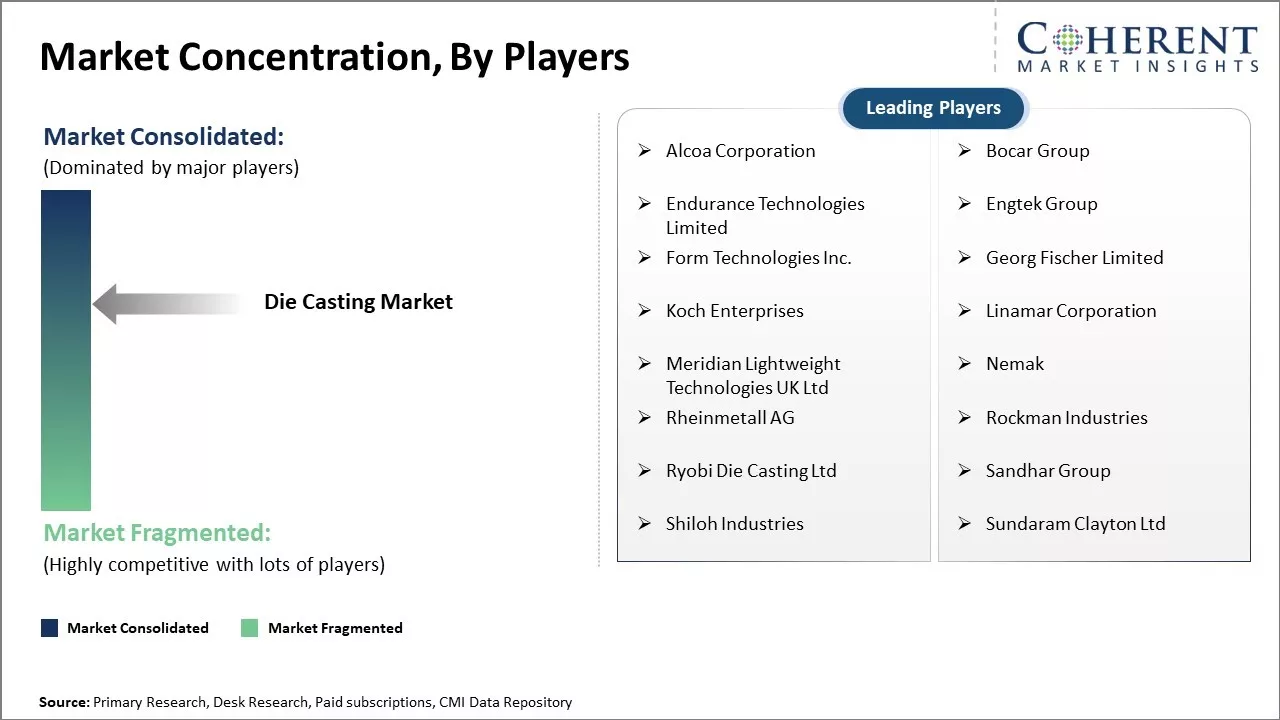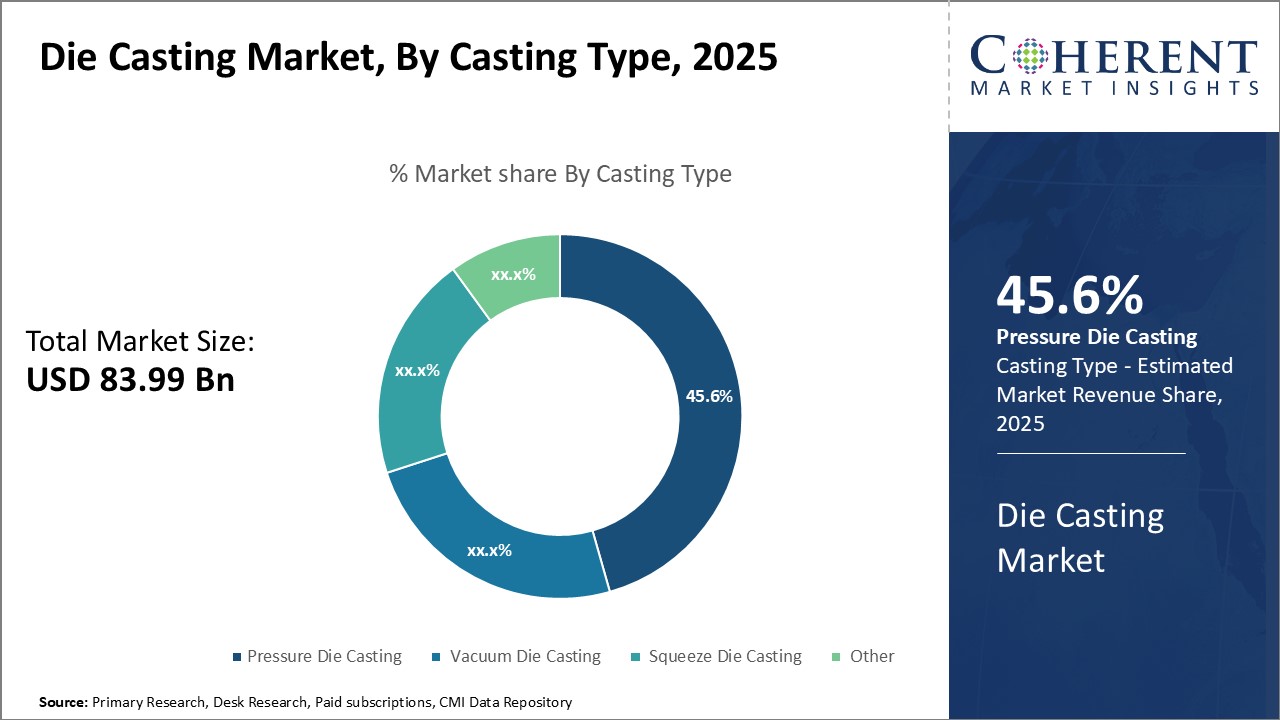The die casting market is estimated to be valued at US$ 83.99 billion in 2025 and is expected to reach US$ 139.43 billion by 2032, exhibiting a compound annual growth rate (CAGR) of 7.5% from 2025 to 2032. Die casting is commonly used in automotive applications where it is valued for its ability to produce complex shapes in high volumes for components like engine parts.

Discover market dynamics shaping the industry: Download Free Sample
The demand for die casting is expected to be primarily driven by the automotive industry over the coming years. As electric vehicles see higher adoption rates, die casting will play a key role in manufacturing drivetrain components like motors and transmission parts which require precision. Growth in other industries such as consumer electronics will also support the rising demand for die casting techniques to manufacture housings, frames, and other metal parts.
Growth in the Automotive Industry
The automotive industry has experienced steady growth over the past couple of decades. Increasing vehicle production across the globe is boosting the need for high-quality and cost-effective die casting components. Automakers around the world are manufacturing more vehicles every year to cater to the growing demand from consumers. This rise in automotive manufacturing is fueling the need for numerous die casted auto parts such as engine parts, transmission components, steering parts, and other complex structural components.
Most die casted parts in the automotive industry have intricate designs and tighter tolerances for dimensional accuracy. This ensures smooth operation and efficient performance of vehicles. Die casting is preferred over other manufacturing processes as it allows for complex designs to be casted in high volumes at reasonable costs. It also helps automakers comply with various performance and emissions standards more effectively. With automakers continuing to launch new vehicle models every year and older models seeing demand, the production of die casted auto components is poised to grow substantially. Various auto market forecasts indicate vehicle manufacturing will increase steadily over the coming years across both developed and emerging nations. This bodes well for the die casting industry as it further expands its penetration in the automotive sector.
For instance, in March 2021, Rheinmetall AG secured an engine block supply contract exceeding EUR 100 million for a prominent Germany-based car manufacturer, with full-scale production slated to commence in 2023 and contract duration extending beyond 2030.

Get actionable strategies to beat competition: Download Free Sample
Growth of Consumer Electronics Industry
Another key growth driver for the die casting industry is the booming consumer electronics market. Cell phones, laptops, desktop computers, gaming consoles, wearable devices, smart home appliances and various other electronic gadgets are becoming an integral part of daily life. Manufacturers in the consumer electronics space are constantly introducing innovative new product designs with added features to attract consumers. Die casting helps electronics brands meet rising expectations of consumers in terms of product design, functionality, and performance.
Complex and lightweight enclosures for portable consumer devices like smartphones and tablets are commonly made from die casted magnesium and aluminum alloy components. This provides strength without adding unnecessary weight. Die casting facilitates the creation of intricate internal frames that deliver structural rigidity. It also aids effective heat dissipation - a critical factor considering the powerful yet compact internals of modern smartphones. As electronics continue to shrink in size while packaging more processing power and connectivity features, die casting is playing a bigger role. It allows makers to cast net-shape parts with great precision and in large volumes to lower production costs. With demand for consumer electronics showing no signs of abating across both developing and developed nations, die casting is expected to see growing use in this high-potential sector.
Key Takeaways of Analyst:
The die casting market is experiencing steady growth driven by increasing demand from the automotive industry. Passenger cars and commercial vehicles are dominating end-use sectors globally and driving more adoption of die casted components. North America and Europe currently dominate the market but fastest growth is seen in developing Asian countries like China, India and Southeast Asia.
Growth in the automotive industry will be the main growth driver for die casting as modern vehicles rely heavily on lightweight die cast parts to meet stringent fuel efficiency and emission norms. Increasing electrification of vehicles also provides opportunities for growth as electric vehicles require more die casted parts compared to internal combustion engines.
A potential restraint could be the rising prices of zinc and aluminum which are major raw materials for die casting. Fluctuations in base metal prices pose a challenge. Other restraints include availability of low-cost alternatives like plastic injection molding and increasing localization requirements pressuring profit margins.
Adoption in other sectors like appliances, electronics, and machinery is expanding the scope of the market as lightweighting trends permeate other industries as well. Ongoing innovation in multi-material design and sophisticated alloy formulations are helping die casting gain preference over other techniques.
Market Challenges: Customization and Cost Pressures in Die Casting
Rising demand for customized products requires manufacturers to reduce tooling costs and quickly switch production between parts, increasing operational complexity. Rising labor and material costs are squeezing profit margins, while the scarcity of skilled labor necessitates further automation, demanding substantial investment. Environmental regulations add to compliance costs due to the handling of hazardous materials and waste production. Additionally, supply chain disruptions, as seen during the ongoing pandemic, highlight the risks of single sourcing for parts, leading to delays and increased costs.
Market Opportunities: Increasing Demand for Lightweight Parts in the Electric Vehicle Industry
The burgeoning electric vehicle (EV) industry is driving a significant demand for lightweight components, which die casting is uniquely positioned to supply. The need for efficient, lightweight parts to enhance vehicle performance and extend battery life makes die casting an ideal manufacturing process. Additionally, the medical devices sector and other precision component markets are expanding, further boosting demand for high-quality die cast parts.

Discover high revenue pocket segments and roadmap to it: Download Free Sample
Insights, By Casting Type - Advancements in die casting techniques drives the pressure die casting segment
In terms of casting type, pressure die casting is expected to contribute the highest share of 45.6% in 2025, owing to the precision it offers along with ability to cast complex and closed cavity parts in high-volume. Pressure die casting yields components with smooth surface finish and dimensional accuracy. It allows the incorporation of detail that may be difficult to achieve with other casting methods. Over the years, pressure die casting techniques have undergone significant improvements through continuous innovations. The development of new sophisticated die casting machines enable producing tight tolerance parts at quicker cycle times. The adoption of advanced computer applications for simulation and modeling has enhanced the quality and consistency of pressure die cast components. This high production rate and precision drives the automotive and electronics industries to widely utilize pressure die casting. Features like net shape casting and ability to cast complex geometries further boost its preference over other die casting types.
Insights, By Material - Growth of aluminum usage favors the aluminum segment
In terms of material, aluminum is expected to contribute the highest share of 64.1% in 2025, attributed to its versatile properties and widespread industrial utilization. Aluminum offers advantages like lightweight, corrosion resistance and precision casting ability. It is highly suitable for automotive industry considering the focus on reducing vehicle weight and improving fuel efficiency. Growing environmental regulations favor aluminum usage as it aids in manufacturing lighter vehicles. Apart from automotive, aluminum die casting finds robust demand from electrical/electronics sector for housings, enclosures and structural parts. It perfectly meets the stringent design requirements of miniaturized electronic components. Rapid expansion of consumer electronics and proliferation of smart connected devices augment the aluminum die casting consumption. Ongoing R&D activities aim to further enhance mechanical and physical properties of aluminum alloys, bolstering its preference over other die casting metals.
By Application - Booming automotive production drives the automotive application segment
In terms of application, automotive is expected to contribute the highest share of 55.6% in 2025, driven by the large scale manufacturing of vehicles across the globe. Die casting method suits the automotive manufacturing due to high-production volumes and precision it offers. It effectively aids in mass producing complex interior and exterior automotive parts with intricate designs. Die casted components find widespread application in the manufacturing of engines, gearboxes, steering systems, and other mechanical modules. Features like vibration damping, dimensional stability, and corrosion resistance make die casting an ideal process for safety critical automotive parts. Additionally, regulatory pressures to curb vehicular emissions and enhance fuel efficiency have prompted automakers to reduce vehicle weight through die cast aluminum and magnesium parts. Growing consumer spending on passenger vehicles along with unveiling of new vehicle models and trim annually fuels the demand for die casted automotive parts.

Need a Different Region or Segment? Download Free Sample
The Asia Pacific region is poised to dominate the die casting market, holding the largest market share of 54.7% in 2025, outpacing all other regions. This significant share is attributed to the region's burgeoning automotive and industrial sectors, which are primary consumers of die cast components. Countries such as China, India, and Japan are leading contributors, driven by rapid industrialization, increasing vehicle production, and the presence of numerous die casting manufacturers. Furthermore, Asia Pacific is expected to exhibit the highest CAGR of 9.2% in 2025, reflecting robust growth prospects. Factors such as advancements in manufacturing technologies, increasing investments in infrastructure, and a growing focus on lightweight and fuel-efficient vehicles are fueling this accelerated growth. The region's ability to produce high-quality, cost-effective die cast parts is also enhancing its competitive edge, making it a pivotal player in the global die casting market.
Die Casting Market Report Coverage
| Report Coverage | Details | ||
|---|---|---|---|
| Base Year: | 2024 | Market Size in 2025: | USD 83.99 Bn |
| Historical Data for: | 2020 To 2024 | Forecast Period: | 2025 To 2032 |
| Forecast Period 2025 to 2032 CAGR: | 7.5% | 2032 Value Projection: | USD 139.43 Bn |
| Geographies covered: |
|
||
| Segments covered: |
|
||
| Companies covered: |
Alcoa Corporation, Bocar Group, Endurance Technologies Limited, Engtek Group, Form Technologies Inc., Georg Fischer Limited, Koch Enterprises, Linamar Corporation, Meridian Lightweight Technologies UK Ltd, Nemak, Rheinmetall AG, Rockman Industries, Ryobi Die Casting Ltd, Sandhar Group, Shiloh Industries, and Sundaram Clayton Ltd |
||
| Growth Drivers: |
|
||
| Restraints & Challenges: |
|
||
Uncover macros and micros vetted on 75+ parameters: Get instant access to report
*Definition: The die casting market involves the process of forcing molten metal under high pressure into a mold cavity. This allows manufacturers to mass produce precision metal parts in high volumes for a variety of industries such as automotive, appliances, and electronics. Common metals used in die casting include zinc, aluminum, magnesium, copper, and tin-based alloys. The die casting market supplies precision metal parts that serve as components and housing for numerous consumer and industrial goods.
Share
Share
About Author
Monica Shevgan has 9+ years of experience in market research and business consulting driving client-centric product delivery of the Information and Communication Technology (ICT) team, enhancing client experiences, and shaping business strategy for optimal outcomes. Passionate about client success.
Missing comfort of reading report in your local language? Find your preferred language :
Transform your Strategy with Exclusive Trending Reports :
Frequently Asked Questions
Joining thousands of companies around the world committed to making the Excellent Business Solutions.
View All Our Clients